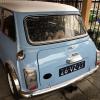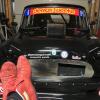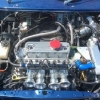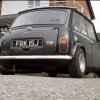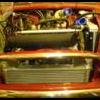Hi Guys, just finished (95%) a nut and bolt restore of my mini.
It is now a 1380cc Engine that has been decked and has a cooper 940G head with larger valves, skimmed polished and ported with roller rockers 1.5 (minispares).
Cam shaft is a Kent cam 286.
The clutch flywheel is lightened to approx 5kg.
It has electronic dizzy from mini spares, specially for a kent cam 286.
LCB (fletcher) Maniflow inlet with double HS4's and K&N's.
The thing is when I am driving and give a good bit of throttle and only when the revs are high it sounds like fuel is igniting in the air filters against the tin k&N cover ( sounds like a tractor)
Not a knocking noise from the engine or bearings.
what could it be (maybe just that, fuel ?)
I have also had a bit of bother with ignition timing and starter motor not wanting to turn, so backed off the dizzy and that helped that...
However I am a bit worried that something is not quite right with the set up ....
Any guys out their with some sound advice please will be welcomed ....
Andy
Mini spares advice for timing: Using the idle adjustment screw on the carb, increase the idle speed to near-enough 2,000rpm. Now slowly and carefully advance the ignition timing by turning the dizzy clockwise whilst keeping your eyes or your assistant's glued to the tacho. As the dizzy is turned, the revs should start to rise. Keep advancing the ignition until the revs stop rising, then retard the ignition by turning the dizzy anti-clockwise until the revs drop by around 250rpm. If the revs don't rise, retard the ignition until you get a marked decrease in the rpm shown, then progress as previously outlined. Once satisfied, turn the ignition off, and nip the dizzy clamp bolt up. Try to do this in a reasonably swift manner to prevent any possible over-heating. Let the engine cool for a while, then re-start and re-set the idle speed. Don't forget - for cams with very sporty profiles that cause rough idling - DO NOT set the idle speed as standard (750-800rpm). This will cause premature valve train damage, let alone cause a mechanical cacophony! An idle speed of 1,000 to 1,100rpm should be your goal.
To double check you're not running into detonation problems, drive the car around using minimum loading (part throttle and use the gearbox) to get the engine up to running temperature. Then drive the car at about 25mph/40kph in third gear and slowly apply the handbrake to two-thirds operation, then accelerate swiftly (i.e. don't just floor it). If any rattling/pinking (detonation) can be heard, back the ignition timing off by a very small amount statically and try again until detonation is eradicated. Alternatively, if no detonation occurs, you can advance the static ignition timing until detonation registers then back it off. The idea is to test the engine at it's most critical rpm range for detonation - around 2,500-3,500rpm (dependent on cam type). If the engine just bogs down, try a slightly higher speed with the aforementioned rpm envelope in mind.
Once happy you've achieved the required goals, check what ignition advance you have at 2,000rpm using a strobe, engine hot, vac-pipe disconnected, using the standard timing marks/pointers if there are any. If not - contrive a pointer that's easy to use. Doesn't have to be exactly at TDC, it's just a reference should you need to disturb any of the ignition components in the future for whatever reason. Make a note of the reading some place safe.
Edited by Andymc, 22 March 2018 - 09:37 AM.


